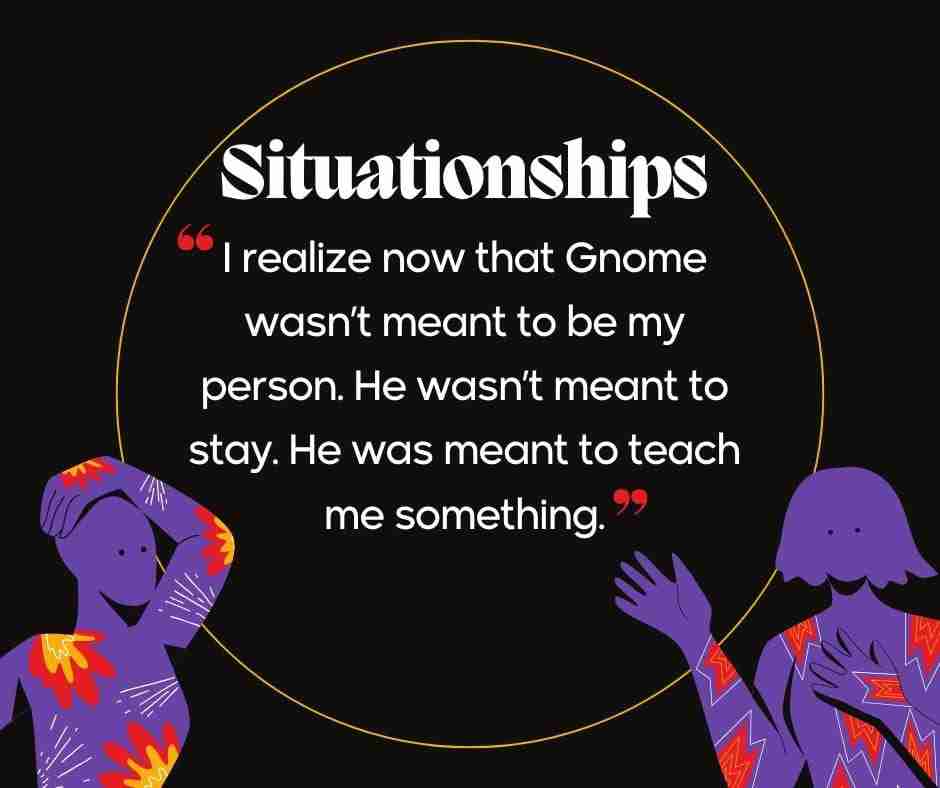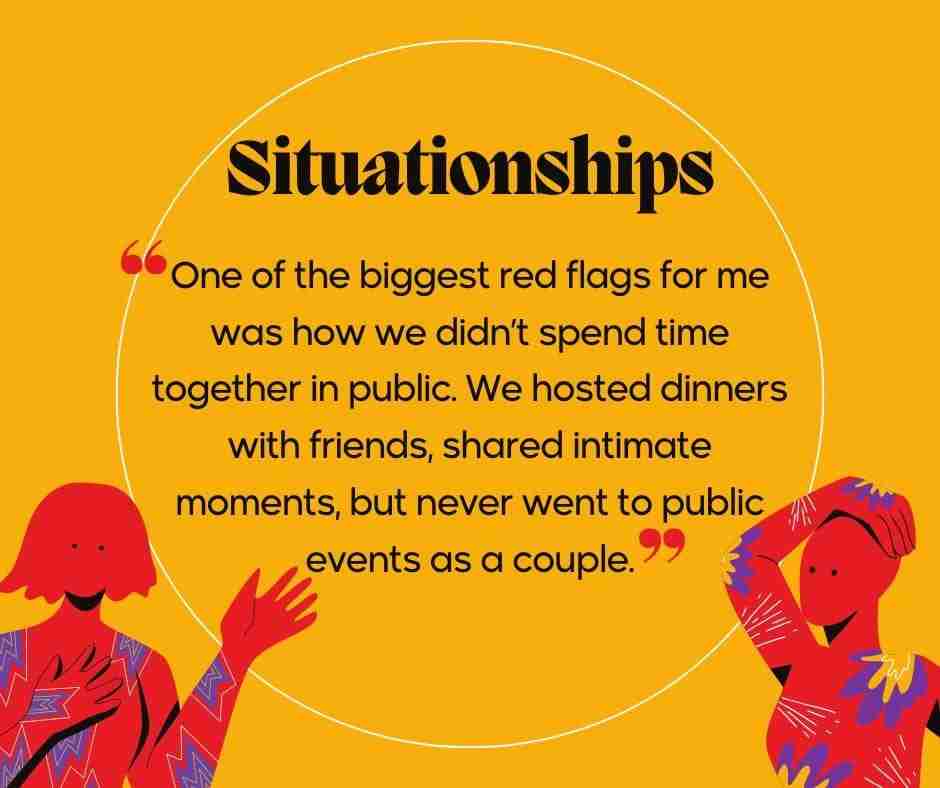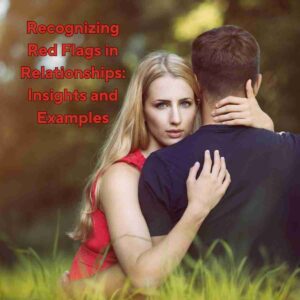Situationships have become a modern dating phenomenon, falling somewhere between a casual relationship (just dating) and committed romantic relationships. In essence, situationships can be defined as spending time with someone, sharing emotional and often physical intimacy, but without a clear definition of the relationship or a long-term commitment.
It lacks the structure of a more serious relationship, but still involves an emotional connection that often feels like dating. The relationship status is ambiguous, and partners may not have discussed their intentions or future. In many ways, it’s about living in the moment without expectations of where the relationship is heading.
Situationships tend to happen when two people are drawn to each other but may not want to label or commit. For some, the lack of clarity works well because it gives a sense of freedom. For others, this ambiguity can lead to confusion, especially when one person develops deeper feelings while the other prefers to keep things casual.
Is a Situationship Like Dating?
Yes, a situationship can feel a lot like dating, but it doesn’t include the structure and clarity of a committed relationship. You may spend time together, have deep conversations, and have a sexual relationship, but there’s no conversation about what it all means. While it resembles a romantic relationship, it doesn’t have the same commitment level or future planning. One person often develops feelings or expectations, while the other may be content with keeping things casual.
An Example of a Situationship
A classic example of a situationship might involve two people who meet through mutual friends. They start spending a lot of time together, texting frequently, and sharing intimate moments, but they never have the “what are we?” conversation. While they spend weekends together, they avoid discussing the future or making things official. It feels like dating, but without commitment or clarity we experience in partnerships that are defined as romantic relationships.
How to Tell if You’re in a Situationship

It’s easy to get caught up in something that feels like it’s moving forward, when in reality, it’s stuck—trapped in a space where the future never comes up and nothing is clearly defined. You find yourself spending time with someone, feeling close, maybe even sharing moments that feel intimate, but you’re always left wondering, “What is this?” That’s when you start to realize you might be in a situationship.
I found myself in this exact place with someone I’ll call Gnome. We had known each other for years through our kids’ sports. He was going through a separation, and what started as me being a supportive friend quickly escalated into something more. We flirted, laughed, and before long, he began staying over.
At first, it was just occasional, but soon it became every night he didn’t have his kids or I didn’t have mine. We would text throughout the day, sharing the mundane details of life, our dreams, and our frustrations. Some nights he’d show up early after work; other nights, it would be much later, depending on his schedule.
It Felt Real
It felt like a real connection. We even hosted Sunday dinners with close friends, cooking and spending time together as if we were a couple. Yet, we never actually acted like a couple in public. When we ran into each other outside of our private moments, we were nothing more than cordial acquaintances. It was like we had an unspoken rule—no public affection, no acknowledgment of what happened behind closed doors. I told myself that was just how things were, that I could live with it. I liked him, and deep down, I hoped this undefined relationship would somehow evolve.
But it didn’t.
We never talked about what we were, and that silence should have been my first clue. But I ignored it because I was scared of pushing him away. I had let my guard down for the first time in years. Gnome was the first person I had been vulnerable with as an adult, after spending years carefully building walls around my heart. He made me feel safe enough to let him in, to show him parts of myself that I kept hidden from everyone else. And because of that, I convinced myself that things were fine, even when they clearly weren’t.
He Wasn’t Meant to Stay
Then, suddenly, he ghosted me. No more texts, no more late-night visits. Just silence. At first, I didn’t panic. I gave him space, thinking maybe he was going through something. But days turned into weeks, and eventually, I confronted him. That’s when he finally told me—he had met someone else.
I was devastated. It wasn’t just the fact that he moved on; it was the fact that I hadn’t even known he was looking. We had agreed to be exclusive, or at least I thought we had. But in reality, I had fallen for someone who was never going to fall for me in return. The emotional weight of that realization crushed me. I’ve been through a divorce, and even that didn’t break me the way this situationship did. For weeks, I couldn’t function at work. I’d never let myself care so deeply, never let myself get so attached, only to be discarded so easily.
To make it worse, the woman he chose was everything I wasn’t. She had multiple children with different dads, no stable home of her own, and lived a party lifestyle. I couldn’t help but wonder, “Why her? Why not me?” I had a solid career, two master’s degrees, a home, and a life that was stable and secure. But he didn’t pick me, and that rejection ate at me for a long time. It made me question my worth, my appeal, and my place in the dating world.
But as time passed, I began to see the truth. It wasn’t about me or my accomplishments; it was about what Gnome was looking for at that time in his life. It wasn’t a reflection of my value. I realize now that Gnome wasn’t meant to be my person. He wasn’t meant to stay. He was meant to teach me something.

What I Learned From My Situationship
I still think of him sometimes, and I smile when I do. Not because I wish things had turned out differently, but because of the fun we had together and the fun we could have had. We shared good times, and in the midst of the heartbreak, I can acknowledge that. But more than that, I know he was meant to show me something important about myself—that I needed to be vulnerable in order to date, to truly let someone in. He taught me that I had the capacity to care deeply and that I could survive the pain that sometimes comes with it.
I’m stronger because of that situationship. Gnome helped me see that resilience doesn’t mean shutting people out; it means opening up and trusting that even if it doesn’t work out, I’ll be okay. I don’t need a partner to be successful. I don’t need validation from someone else to feel worthy. I’ve learned to stand on my own two feet and embrace my independence.
So if you find yourself in a situationship, spending time with someone but never quite knowing where you stand, don’t be afraid to ask the tough questions. Make it a point to get on the same page. Define the relationship. Don’t settle for the ambiguity that leaves you second-guessing your self worth. Because if I’ve learned anything, it’s that clarity is a gift you owe to yourself, even if it means facing a painful truth.
What Are the Rules in a Situationship?
The rules in a situationship depend entirely on the people involved. In my experience, the situationship with “Gnome” had its own set of unspoken rules. We weren’t open about our relationship to others. Our close friends knew, but publicly we acted like just friends. One of the biggest red flags for me was how we didn’t spend time together in public. We hosted dinners with friends, shared intimate moments, but never went to public events as a couple.

With Gnome, the rules were unclear because, in my mind, we were getting closer. We shared our future dreams and spent nearly every other night together. But looking back, I missed some significant red flags, such as him leaving early in the morning or coming over late at night—signs that something wasn’t quite right. In the end, he found someone else without telling me he was even looking.
Does Being in a Situationship Mean You’re Single?
Whether a situationship means you’re single depends on the person. For me, I was single in the sense that I wasn’t looking for anyone else while I was with Gnome. However, Gnome was still searching, which ultimately hurt me when he found someone else. Situationships often come with this kind of ambiguity—one partner may feel emotionally invested while the other keeps their options open.
Classic Signs of a Situationship
Certain red flags often pop up in situationships that aren’t usually present in committed relationships. These signs can be easy to overlook, especially if you’re caught up in the moment or hoping things will eventually change. But ignoring them can leave you stuck in a place that’s emotionally draining. Here are some of the situationship flags I personally encountered, along with some that may resonate with others:
Not Spending Time Together In Public
If you’re spending a lot of time with someone privately but never doing things together publicly—like going out for dinner, attending events, or simply running errands together—that’s a red flag. This could indicate that the other person is keeping the relationship hidden, either because they’re not fully committed or they’re seeing other people.
Acting Like Only Friends in Public
Even when Gnome and I did run into each other in public, we acted like mere acquaintances. There was no affection or recognition of the intimacy we shared in private. If someone is warm and affectionate with you behind closed doors but distant in public, it’s a sign that they’re not ready to acknowledge what’s really going on.
Unstable Living Situation
In Gnome’s case, he was sleeping on his mom’s couch because he didn’t have a place of his own. While everyone goes through tough times, a partner’s inability to get their life in order—whether it’s financially, emotionally, or logistically—can be a sign that they’re not in a place to offer stability or commitment.
Late-Night Visits and Early Departures
If someone only comes over late at night and leaves early in the morning, it can make you feel like they’re only interested in the physical aspects of the relationship and not in building an emotional connection. This pattern can be a major sign that the relationship is not progressing toward something more serious.
No Conversations About the Future
If you’ve been seeing each other for quite some time (you may even consider it a long-term relationship), and there’s still no talk about the future, whether that’s in terms of commitment or even simple plans, it’s a sign that the relationship might not be going anywhere. The absence of long-term discussions often indicates that the other person isn’t looking for a serious relationship.
Inconsistent Communication

One day, they’re texting and calling you regularly, and the next, you barely hear from them. Inconsistent communication can be a sign that they’re not prioritizing the relationship, or that they’re keeping you at a distance emotionally. Consistency in communication is key in any relationship, casual or not.
Vague or Shifting Boundaries
Situationships often lack clear boundaries, and this vagueness can leave you feeling confused about what’s acceptable. If the other person avoids conversations about what you are, or constantly shifts the boundaries of what’s okay (e.g., “We’re just having fun, no need for labels” or “We don’t need to tell people about us”), that’s a red flag.
No Integration Into Their Life
If after months of seeing someone, you still haven’t met their friends or family—or even know much about their day-to-day life—that’s a warning sign. A person who isn’t ready to introduce you to their inner circle may not be serious about moving the relationship forward.
Excuses for Avoiding Commitment

When someone constantly says things like “I’m not ready for a relationship right now” or “I just want to keep things casual,” but continues to spend a lot of time with you, they might be stringing you along. Pay attention to their actions, not just their words.
Feeling Like You’re Always Waiting
If you’re waiting for them to text first, waiting for them to suggest plans, or just waiting for them to make up their mind about what they want, you’re likely not in a relationship that’s built on equal footing. A healthy relationship involves both partners actively participating, not one person doing all the emotional labor.
These signs often reflect that the relationship isn’t progressing forward or becoming more defined. It’s easy to get swept up in the idea that things will change if you just give it more time, but situationships tend to stay stagnant.
If you find yourself encountering these red flags, it’s important to take a step back and assess whether this relationship is truly serving your emotional and mental health. Remember, you deserve clarity, consistency, and commitment—don’t settle for anything less.
Moving On from a Situationship

Situationships can teach us hard but necessary lessons about emotional vulnerability and resilience. My situationship with Gnome wrecked me in ways I didn’t expect. We weren’t officially together, but his decision to pursue someone else felt like a deep, personal rejection that tore open wounds I didn’t even know were there. It was the first time in years—maybe in my adult life—that I had allowed myself to be truly vulnerable with someone. The kind of vulnerability where you strip away all the layers, let down the walls, and expose the parts of yourself that you’ve kept hidden out of fear or protection.
When Gnome walked away, it forced me to confront some hard truths about myself. I had spent years perfecting the art of compartmentalizing my life, of showing only the sides of me that felt safe. But when I let him in, it felt different. He saw my quirks, my eccentricities, my anxieties. He saw the side of me that I’d been too afraid to show anyone else for so long. And when he chose someone else, it was like he was saying that those pieces of me weren’t enough.
That experience made me spiral into doubt—about my worth, my attractiveness, my place in the world of dating. I questioned why I wasn’t chosen, what was so wrong with me that someone would walk away from all that I had to offer. I kept comparing myself to the woman he chose, thinking about how she didn’t have the things I had worked so hard for; the education, the career, the stability. It hurt because I believed that I had done everything “right,” but I still wasn’t enough for him.
Learning to Be Vulnerable
I know now that it wasn’t about me. It took time, but I’ve come to understand that Gnome wasn’t rejecting who I am, even if it felt like that. He was just looking for something different. That realization didn’t make the pain disappear, but it allowed me to see the situation for what it was: a necessary heartbreak that pushed me to grow. He came into my life to teach me something critical—that if I want to find a real connection, I have to be unapologetically open and honest about who I am and what I need.
Being vulnerable doesn’t come naturally to me. I’ve always prided myself on being strong and independent, someone who could handle anything on my own. But I’ve learned that true strength doesn’t come from hiding behind walls. It comes from letting those walls down and being brave enough to show people the real you, flaws and all. That’s where I am now—working on being fully, unapologetically myself. I’m learning that in order for people to truly see me, to know me, I have to be vulnerable. It’s not about being weak; it’s about being real.
I’m also learning how to be open without being rude. I’m a straightforward person, and sometimes that comes off as harsh or blunt. But I don’t want to lose that part of myself—my honesty is a gift. What I’m working on now is finding that balance between being honest and being gentle, between showing up as my true self without pushing people away with my intensity. I want to communicate what I need in relationships, but I also want to give grace and allow space for others to meet me where I am.
Building Something Real
This journey isn’t easy. It’s hard to open yourself up, to show your scars and hope someone doesn’t flinch at the sight of them. But I’m doing it because I know that’s the only way to truly connect with someone on a deeper level. Now I know that I can’t settle for the ambiguity of a situationship, for the half-hearted affections or undefined boundaries that leave me second-guessing where I stand. I want clarity, I want commitment. I want to build something real, with someone who sees me for everything I am and still chooses to stay.
I’m still working on me, still figuring out how to navigate this world of relationships. But I know one thing for certain: I deserve someone who is willing to meet me halfway, who isn’t afraid of my vulnerability, my quirks, or my strength. And until I find that, I’m content with standing tall on my own, knowing that being strong doesn’t mean being closed off. It means being brave enough to let people in, even when it scares you.



























0 Comments